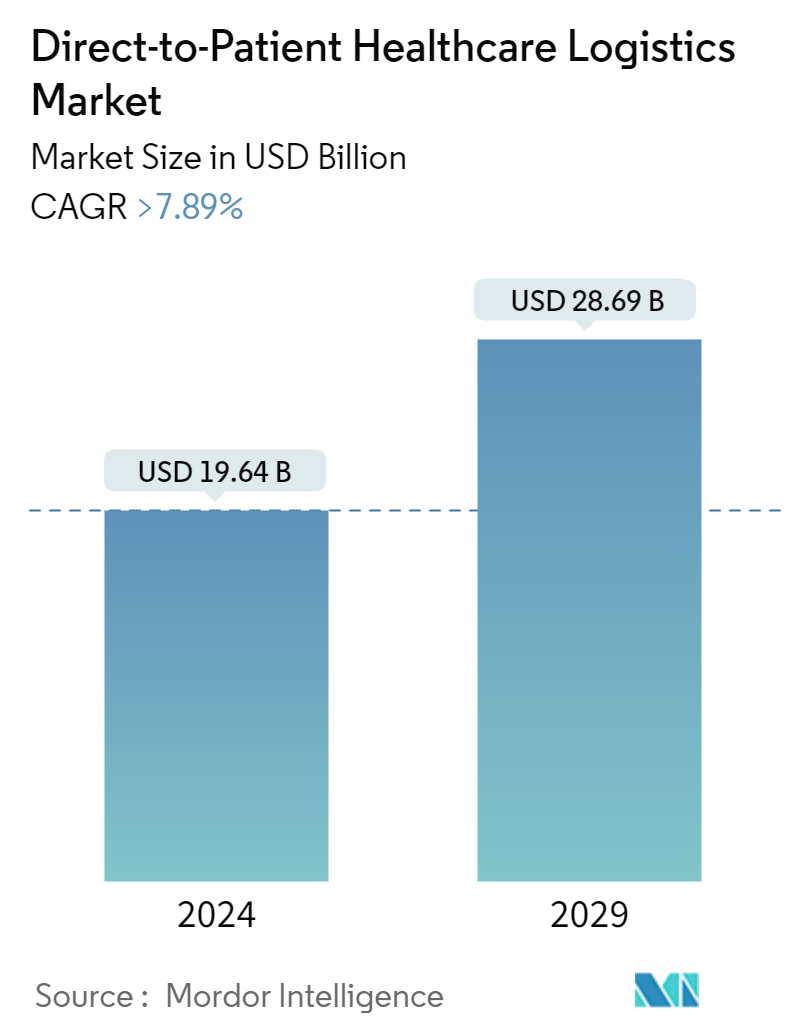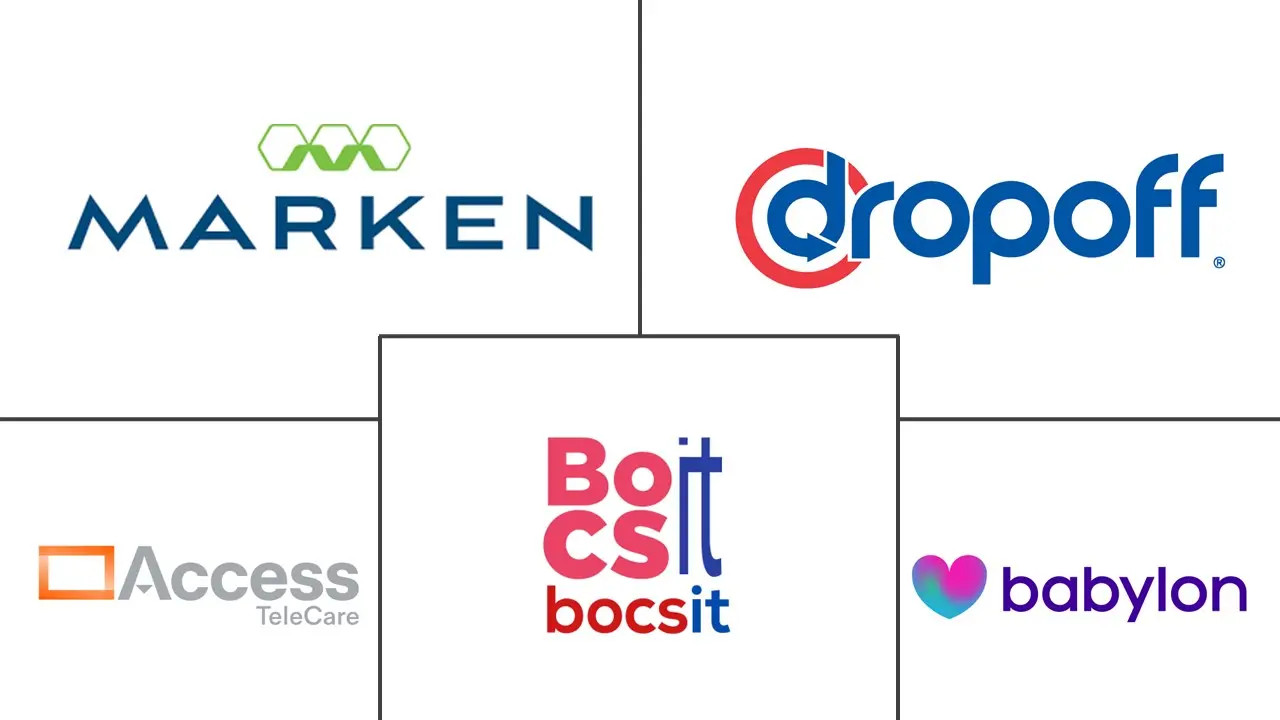Market Size of Direct-to-Patient Healthcare Logistics Industry

| Study Period | 2020 - 2029 |
| Base Year For Estimation | 2023 |
| Market Size (2024) | USD 19.64 Billion |
| Market Size (2029) | USD 28.69 Billion |
| CAGR (2024 - 2029) | 7.89 % |
| Market Concentration | Low |
Major Players
*Disclaimer: Major Players sorted in no particular order |
Direct-to-Patient Healthcare Logistics Market Analysis
The Direct-to-Patient Healthcare Logistics Market size is estimated at USD 19.64 billion in 2024, and is expected to reach USD 28.69 billion by 2029, growing at a CAGR of greater than 7.89% during the forecast period (2024-2029).
In the fast-evolving healthcare landscape, direct-to-patient (DTP) logistics has emerged as a transformative force, redefining the traditional approaches to healthcare delivery. Yet many organizations need to be aware of the process and its benefits despite their enormous potential for streamlining an effective supply chain that could save millions of human lives.
Several seminars, including medicines training, pharmaceutical equipment, good clinical practice, study design, pharmacovigilance, and interpretation of clinical trials, are made available to employees at no cost.
Clinical trials have always been the main barrier to introducing a new medicinal product. The authors of the World Pharma Today article suggest that testing a single drug costs approximately USD 2.6 billion, with each patient significantly impacting its development cost and length of studies.
In the United States, 40% of people opt out of medical tests/treatment due to a lack of healthcare facilities. In addition, more reasonable access to pharmacies and other medical supply stores for an estimated 100 million Americans must be available.
The direct-to-patient logistics improve the overall patient experience and contribute to better health outcomes. Routine medical visits do not entail the inconvenience of travel or disruption of daily life for patients. Adherence is improved, and patients are empowered to actively participate in their care journey through the convenience of receiving medicines, clinical trial supplies, and healthcare services at their doorstep.
Direct-to-Patient Healthcare Logistics Industry Segmentation
Direct-to-patient healthcare logistics is a strategy that brings medications, medical supplies, and clinical trial necessities directly to patients' homes. This approach ensures accessibility and convenience, revolutionizing the pharmaceutical industry and the nature of patient care.
A complete background analysis of the direct-to-patient healthcare logistics market, which includes an assessment of the sector and the contribution of the industry to the economy, market overview, market size estimation for critical segments, key regions, and emerging trends in the market segments, market dynamics, and essential production and consumption statistics are covered in the report.
The direct-to-patient healthcare logistics market is segmented by product (prescribed medicine delivery, pre-clinical supplies, clinical trial supplies, home trial support, and test samples collection), temperature type (ambient, chilled/refrigerated, frozen, cryogenic), and region (North America, Europe, Asia-Pacific, Middle East and Africa, and Latin America). The report offers market size and forecasts for the direct-to-patient healthcare logistics market in value (USD) for all the above segments.
| By Product | |
| Prescribed Medicine Delivery | |
| Pre-Clinical Supplies | |
| Clinical Trial Supplies | |
| Home Trial Support | |
| Test Samples Collection |
| By Temperature Type | |
| Ambient | |
| Chilled/Refrigerated | |
| Frozen | |
| Cryogenic |
| By Region | ||||||||
| ||||||||
| ||||||||
| ||||||||
| ||||||||
|
Direct-to-Patient Healthcare Logistics Market Size Summary
The Direct-to-Patient Healthcare Logistics Market is experiencing significant growth, driven by the need for efficient and patient-centric healthcare delivery systems. This market is reshaping traditional healthcare approaches by facilitating the delivery of medicines, clinical trial supplies, and healthcare services directly to patients' homes. The rise in chronic diseases and the increasing demand for convenient care solutions, such as telemedicine and e-prescriptions, are key factors propelling this market forward. Companies like Amazon and Uber are pioneering innovative delivery methods, including drone services and direct-to-patient shipping, to enhance accessibility and adherence to treatment plans. The integration of advanced technologies and partnerships, such as those between Walgreens and Labcorp, are further expanding the reach and efficiency of healthcare logistics.
The market landscape is becoming increasingly competitive, with several companies leading the charge in transforming healthcare logistics. Organizations like Marken, Dropoff, Access TeleCare, Babylon Health, and Bocsit are at the forefront, driving advancements in patient care and pharmaceutical supply chains. Strategic acquisitions, such as UPS's acquisition of MNX Global Logistics, are enhancing time-critical logistics capabilities, particularly in key regions like the United States, Europe, and Asia. Collaborations, such as the one between SkyCell and Marken, are providing advanced shipping solutions for temperature-sensitive pharmaceutical products, underscoring the market's focus on innovation and efficiency. As the demand for direct-to-patient services continues to rise, the market is poised for substantial growth, offering promising opportunities for stakeholders across the healthcare spectrum.
Direct-to-Patient Healthcare Logistics Market Size - Table of Contents
-
1. MARKET INSIGHTS ANS DYNAMICS
-
1.1 Market Overview
-
1.2 Market Drivers
-
1.2.1 Booming Telehealth to Fuel Market
-
-
1.3 Market Restraints
-
1.3.1 Legal Restrictions
-
-
1.4 Market Opportunities
-
1.4.1 Advanced Telehealth Technologies
-
-
1.5 Value Chain / Supply Chain Analysis
-
1.6 Porter's Five Forces Analysis
-
1.6.1 Threat of New Entrants
-
1.6.2 Bargaining Power of Buyers/Consumers
-
1.6.3 Bargaining Power of Suppliers
-
1.6.4 Threat of Substitute Products
-
1.6.5 Intensity of Competitive Rivalry
-
-
1.7 Impact of COVID-19 on the Market
-
-
2. MARKET SEGMENTATION
-
2.1 By Product
-
2.1.1 Prescribed Medicine Delivery
-
2.1.2 Pre-Clinical Supplies
-
2.1.3 Clinical Trial Supplies
-
2.1.4 Home Trial Support
-
2.1.5 Test Samples Collection
-
-
2.2 By Temperature Type
-
2.2.1 Ambient
-
2.2.2 Chilled/Refrigerated
-
2.2.3 Frozen
-
2.2.4 Cryogenic
-
-
2.3 By Region
-
2.3.1 North America
-
2.3.1.1 United States
-
2.3.1.2 Canada
-
2.3.1.3 Mexico
-
-
2.3.2 Europe
-
2.3.2.1 Germany
-
2.3.2.2 United Kingdom
-
2.3.2.3 France
-
2.3.2.4 Russia
-
2.3.2.5 Spain
-
2.3.2.6 Rest of Europe
-
-
2.3.3 Asia-Pacific
-
2.3.3.1 India
-
2.3.3.2 China
-
2.3.3.3 Japan
-
2.3.3.4 Rest of Asia-Pacific
-
-
2.3.4 South America
-
2.3.4.1 Brazil
-
2.3.4.2 Argentina
-
2.3.4.3 Rest of South America
-
-
2.3.5 Middle East and Africa
-
2.3.5.1 United Arab Emirates
-
2.3.5.2 Saudi Arabia
-
2.3.5.3 Rest of Middle East and Africa
-
-
-
Direct-to-Patient Healthcare Logistics Market Size FAQs
How big is the Direct-to-Patient Healthcare Logistics Market?
The Direct-to-Patient Healthcare Logistics Market size is expected to reach USD 19.64 billion in 2024 and grow at a CAGR of greater than 7.89% to reach USD 28.69 billion by 2029.
What is the current Direct-to-Patient Healthcare Logistics Market size?
In 2024, the Direct-to-Patient Healthcare Logistics Market size is expected to reach USD 19.64 billion.

